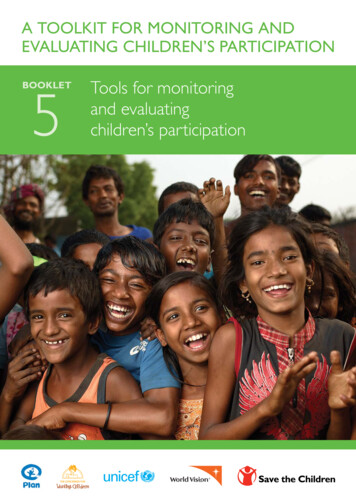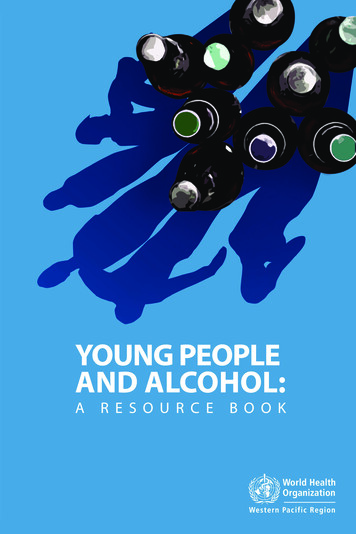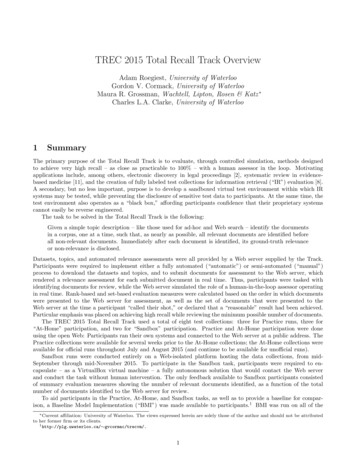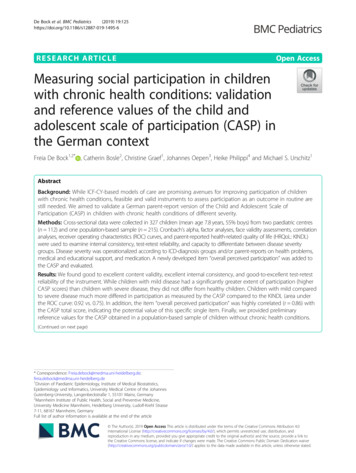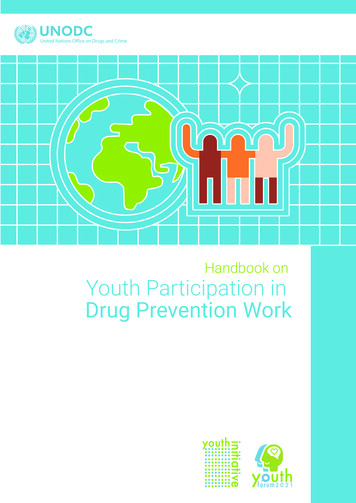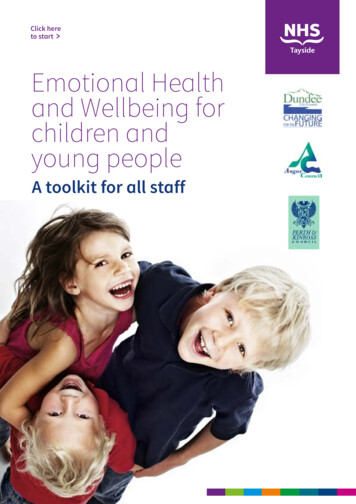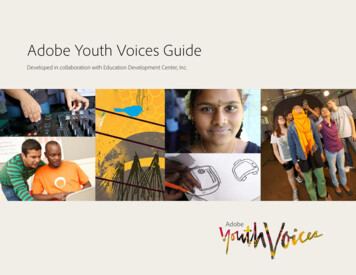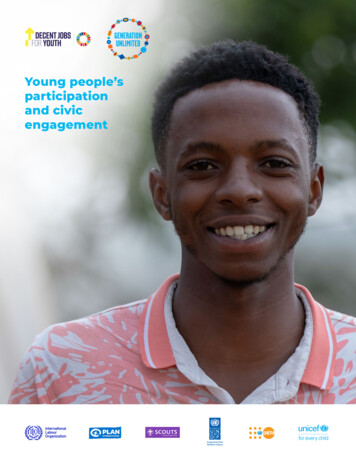
Transcription
Young people’sparticipationand civicengagement
Generation UnlimitedGeneration Unlimited works with atwo- pronged approach- coordinatingcountry level action through investmentagendas and implementing crosscutting innovations at scale. Atthe national level, GenerationUnlimited will establish an in-country,multisector partnership group ledby the government to undertake acomprehensive landscape analysis ofthe current ecosystem for education,employment and civic engagement ofyoung people. The analysis will be thebasis for a country investment agendathat will articulate a high-level roadmapand a portfolio of scalable initiatives forinvestments, and Generation Unlimitedsupport sourcing of investmentopportunities and mobilization offinancial and political capital to executeon these priorities for young peopleaged 10-24. Where innovations arerequired, Generation Unlimited willalso support co-creation of solutions,particularly with young people.At the global level, Generation Unlimitedwill identify and scale innovations ofgreatest potential to address commonchallenges of young people, unlockingbottlenecks and brokering partnershipsto deliver on the innovations.Decent Jobs for Youth, theGlobal Initiative for ActionDecent Jobs for Youth is the global initiativeto scale up action and impact on youthemployment under the 2030 Agenda forSustainable Development. It is a hub forcatalyzing partnership, collaborationand coordinated action at country andregional level, grounded in evidence-basedsolutions.Launched in 2016, with the endorsementof the United Nations Chief ExecutivesBoard for Coordination, Decent Jobsfor Youth brings together governments,social partners, youth and civil society, theprivate sector, and many more partnersadvancing the vision: a world in whichyoung women and men everywhere havegreater access to decent jobs!Through the commitment platform andthe Decent Jobs for Youth KnowledgeFacility, partners identify what works, shareinnovations, and mobilize concrete actions– from green and digital jobs to qualityapprenticeships, youth entrepreneurship,and the transition to the formal economy.With new spin-off initiatives in Namibia,Nigeria, Burkina Faso, and Kenya, and aregional and global convening agenda,Decent Jobs for Youth works with likeminded partnerships to translatefragmentation into synergy.Acronyms and initialismsAIDSAcquired Immune Deficiency SyndromeCRCConvention on the Rights of the ChildDRCDemocratic Republic of CongoESDEducation for Sustainable DevelopmentGCEGlobal Citizenship EducationHIVHuman Immuno-Deficiency VirusIEAInternational Association for the Evaluation of EducationalAchievementSASMStudent Anti-Sweatshop MovementSDGSustainable Development GoalUNESCOUnited Nations Educational, Scientific and Cultural OrganizationUNICEFUnited Nations Children’s FundUNVUnited Nations VolunteersUS United States Dollar
INTRODUCTIONThe current generation of young people –numbering 1.8 billion – is one-quarter of the1world’s population and a dominant forcenow and in the decades to come. However,investments in quality wage and selfemployment fall short of young people’saspirations, leaving a growing pool of youngjobseekers with an insufficient number ofdecent jobs. Many education systems arestruggling to prepare young people withskills which meet employer’s expectations.The COVID-19 pandemic and related globalrecession have further exacerbated thesocio-economic challenges facing youth,which put at risk many of the gains madein recent years to advance young people’sopportunities.Generation Unlimited and the GlobalInitiative on Decent Jobs for Youth aretwo multi-stakeholder alliances workingtogether to mobilize action and fosterskills, employment and the meaningfulparticipation of young people across theglobe. By bringing young people togetherwith governments, social partners, theprivate sector, and a range of internationaland local organizations, they connectsecondary-age education and training to acomplex and fast-changing world of work,while easing the transition of young peopleinto decent jobs. Efforts are also being madeto foster youth-led entrepreneurship andempower a generation of young people tofully engage as part of their societies.1
SECTION 1 THE STRATEGIC CASEThe 1.8 billion youngpeople in the world todayare a crucial resource forinnovative social changetowards a more equaland sustainable world.Throughout history,civically engaged youngpeople have proven tobe a powerful force forchange. In recent yearsalone, we have witnessedyouth-led movementsthat have successfullygained internationalattention and challengedestablished practiceswithin public, privateand not-for-profitorganizations andinstitutions.Young people first and foremost havea fundamental right to participate andengage meaningfully in society. Accordingto Article 12 of the United NationsConvention on the Rights of the Child,signed by 196 countries, young peoplehave the right to have their voices listenedto and taken into account in decisions thataffect their lives.2 This right, alongside otherrights outlined in the Convention such asthe right to non-discrimination (Article2) and freedom of expression (Article 13),puts a duty on governments to create anenabling environment for young peopleto influence decisions and policies thatimpact them. The 2030 Agenda recognizesthat “children and young women andmen are critical agents of change andwill find in the new Goals a platform tochannel their infinite capacities for activisminto the creation of a better world".3 Inaddition, in a 2013 resolution the UnitedNations General Assembly urged “MemberStates and entities of the United NationsSystem, in consultation with youth-ledorganizations, to explore avenues topromote full, effective, structured andsustainable participation of young peopleand youth-led organizations in decisionmaking processes”.4 This resolution wasreinforced by the United Nations HumanRights Council in 2016.5Despite these rights, young people still faceunequal opportunities for participationand civic engagement. They typicallyexperience a lack of voice and power tomake decisions that affect their lives andto create positive social change. This istrue across many contexts including thehome, education, local communities, work,business and the political sphere. Whenforms of youth consultation do occur, thetopics are frequently tokenistic in nature,not given the same weight as adults, andare hardly ever acted upon.6This reality does not only breach a basichuman right, but also leads to untappedpotential for youth development andsocial improvement. When youngpeople meaningfully engage in decisionmaking, it improves their problemsolving, negotiation and communication2skills, enables them to build betterrelationships,7 and leads to policies anddecisions that are more likely to addresstheir needs.8, 9 Furthermore, given aconducive environment, young peoplecan then use these skills to strengthencivil society, increase accountability ofgovernments and corporations10 andwork towards greater social cohesion.Lastly, when youth are enabled andsupported, their participation andengagement can be a powerful meansfor them to challenge situations of abuse,injustice and discrimination.11On the positive side, there are manyencouraging examples of significantimprovements in young people’sparticipation and influence in the home,at school, in their communities and inthe political sphere at local, nationaland global levels. At local level, anexample is greater youth participationand contribution to decision-making incity and district councils in Sierra Leonesince the end of the civil war.12 At nationaland global level, an example is theinclusion of youth delegates in countries’official delegations to the United NationsGeneral Assembly. Youth representativesprovide input to their delegations onissues related to youth and participatethrough attending national andintergovernmental meetings andinformal negotiations. In the politicalsphere, young female leaders have takencentre stage, from Malala Yousafzai’sinvolvement in strengthening the globalmovement for girls’ rights to educationthrough to Greta Thunberg igniting amovement of young people protestingand striking in demand for action tomitigate climate change. In 2018 we sawyoung people leading the protests forgun control in the United States. In 2019we witnessed young people protestingin support of democracy and humanrights in Algeria, Chile, Egypt, HongKong, Indonesia, Iran, Iraq, Lebanon,Russia and Sudan. Not only have youngpeople continuously demonstrated theircapability to lead change, but the dataalso suggest that young people (18–34)participate in demonstrations more thanadults (35 upwards).13
Defining theopportunities andchallengesThe aim of this guide is to support theGeneration Unlimited strategic priorityto “Equip young people as problem-solversand engaged members of society, helping tocreate a better world”, through providingevidence and guidance that has thepotential to improve young people’sparticipation and civic engagement. Thisguide will identify successful strategiesthat can increase young people’s civicparticipation and boost the knowledge,skills, attitudes and values crucial for futurecivic engagement. It will identify structuresthat are likely to amplify young people’svoices in decision-making and benefit localcommunities.Participation and civic engagement arevery broad and contested concepts thathave been stretched and interpreted inmany different ways.14 For this thematicguide, the following working definitionshave been used: Participation is understood in termsof a process, i.e., “partaking in, andinfluencing, processes, decisionsand activities”,15 where such behaviourrequires positive attitudes, dispositionsand interests in participation, along with aclear belief that one can make a difference.The definition insists on the need forparticipation to be anchored in the valuesof human rights and based on knowledgeand critical reflection. Civic engagement is defined as “how anactive citizen participates in the lifeof a community in order to improveconditions for others or to help shapethe community’s future.” 16There are a wide variety of challengesthat young people face in their path toparticipation and civic engagement.Young people’s right to be heard andinfluence decisions in a meaningfulway is rarely upheld and supported.When young people are asked about theirexperience of involvement in decisionmaking, the experience they describeis complex. For example, young peopleengaged in youth councils in the UnitedStates reported experiences of adults nottaking their ideas seriously.17 Research inGhana identified another barrier – whenyoung people behaved like adults theywere viewed as not representing the viewsof youth and when they behaved like youththey were removed from the consultationexercise and replaced.18 These barriers toinfluence and participation in decisionmaking are not unique, but are indicativeof young people’s experiences of youthvoice more broadly.There is a lack of awareness andcapacity among adults to equip youngpeople with the tools, support andencouragement needed to be civicallyengaged. Be it social workers, healthcareprofessionals, teachers, youth employersor caregivers, many adults do not havethe skills and awareness to support andmotivate young people to express theirviews and opinions and to be active intheir communities and in wider society. Anexample of this challenge is the scarcityof quality teaching on youth participationand civic engagement. Despite teachers’great influence on young people’s lives, themajority of teachers are not adequatelytrained to use the teaching approachesrequired to build the knowledge, skills,attitudes and values needed for futureparticipation and civic engagement.The lack of initial and continuousprofessional development on educationfor sustainable development or globalcitizenship education was highlighted byUNESCO as one of the major challenges forimplementing Sustainable DevelopmentGoal target 4.7.1 on global citizenship.19Young people face stigma regardingtheir characteristics and influenceon society. With rising global concernsof terrorism, young people are frequentlyassociated with violence and extremismand at times labelled as a threat. Thesestigmas fuel policies that marginalizeyoung people and evoke security measuresagainst them, rather than leading to moresupportive solutions that enable them toparticipate positively in society.20 Indeed,the stigmatism of young people extends3
further still. In a survey in Scotlandregarding public attitudes towards youngpeople, 25 per cent viewed young peopleas lazy, 40 per cent thought they lackedcommunication skills and 33 per cent sawthem as irresponsible. When respondentswere asked about the portrayal of youngpeople in the media, 52 per cent feltthey were portrayed in a negative light,21which could partially explain the negativeperceptions held by some. However, likeany other group in society, young peopleare heterogeneous, and although thesenegative perceptions might hold true insome cases, the stigma they face as agroup acts as a barrier to their positiveengagement in society.Beyond the challenges faced by youngpeople as a whole, there are uniquechallenges for specific groups of youngpeople. Vulnerable and marginalizedyouth face inequities in access toopportunities for civic engagement.These inequities affect which youngpeople have the opportunity toparticipate in activities such as schoolcouncils, youth councils,22 volunteering4or peer-to-peer initiatives. Access to suchopportunities is commonly influencedby socioeconomic status, gender,sexual orientation, ethnicity, citizenshipand disability, with participation beingdominated by young people who comefrom a more advantaged background.Though these experiences of meaningfulparticipation are known to developthe skills for future political leadershippositions, they still rest within the hands ofa privileged few.There is a lack of data and researchavailable on the impact of youngpeople’s participation and civicengagement, which hinders theidentification of effective strategies.Due to these data and research gaps,those initiatives which are designed toboost participation and civic engagementhave limited capacity to foster evidencebased practice, and to identify and scaleup best practice. This challenge, discussedin more detail below in the section ongaps in the research, is an underlyingconstraint in addressing the issueshighlighted in this guide.Landscape – Participationand civic engagementtrends amongst youthAs highlighted in the introduction, youthhave the potential to be a positive forcefor change. United Nations SecurityCouncil Resolution 2250 on Youth, Peaceand Security highlights the importance ofunderstanding young people’s concerns,grievances and responsibilities, andemphasizes the need for young people to bemeaningfully engaged in decision-makingso that they can contribute to buildingmore equitable and peaceful societies.23The United Network of Young Peacebuildersundertook a consultation with over 140young people from 56 countries. Theconsultation highlighted the “optimisticindividual attitudes and behaviours ofmany young people driving peacebuildingefforts”, and commented that despite oftenbeing excluded from political and policyprocesses, “most young people do notturn to violence as a solution for politicalchange”.24
Beyond positive attitudes and behaviours,young people are also becoming effectivesocial activists by increasing their reachand impact through social media. Forexample, it is becoming increasinglycommon for young people to use TikTok,one of the biggest social media platformstoday with a young user demographic, forsocial activism. Young people have usedthe platform to organize a student strikeover teachers’ pay, share their experiencesof racism and raise awareness of climatechange.25 In addition, many of the recentprotests mentioned in the introduction havebeen supported by social media networksboth locally and internationally, spreadingideas and creativity which authoritarianstates then attempted to close down.26Young people’s participation alsomanifests itself in their involvement indecision-making that affects their livesthrough school councils, student unions,youth clubs, national youth parliaments,regional and international youth forumsand advisory councils for internationalorganizations. It certainly appears thatthe number of channels and structures foryouth participation has increased since theUnited Nations Convention for the Rightsof the Child was adopted in 1989, althoughthis cannot be established on the basis ofany existing evidence base.conventional forms of political engagementsuch as voting and being a member of apolitical party.28, 29, 30, 31 This is also reflectedin the fact that only a few parliamentariansare young people.32 As discussed in theopportunities and challenges section, thereare additional inequalities when lookingat sub-groups of young people. Across theworld, there are large gender inequalitiesas regards empowerment and politicalleadership.33 For example, there are fewerpolitical party members that are youngwomen than young men, and youngwomen make up only 40 per cent of theworld’s young parliamentarians.34, 35 This isin part due to the social norms and culturalattitudes which discourage young womenfrom civic engagement, which in turnreduces their motivation to be politicallyactive. Education levels also influence mostforms of political engagement, skewing ittowards those with more education. Theseinequalities by age and sub-groups havean impact upon young people, and inparticular disadvantaged young women,as their needs are less likely to be taken intoaccount in decisions which affect their lives.Young workers also have less say intheir working lives than older workers.Trends suggest that young people aremore likely to be in jobs that do notallow for trade union representation;and where such representation is notformally debarred, the relatively shortduration of job contracts for those nowentering the labour market meansthat young people have less time toself-organize, and do so at greaterrisk since they tend to have less securecontracts than older workers. Youngpeople who do participate in unionsoften face institutionalized inequalities.For example, negotiations can lead totwo-tier contract arrangements in whichconcessions are made for young andnew workers so that senior employeesmay retain their terms and benefits.Despite this situation, young people at alllevels have been active in trade unions –developing young workers’ committeesto help young people participate inunions’ democratic processes, andadvocating union structures that fairlysupport young workers.36Young people are also involved involunteering and civic service programmes,although there is no up-to-date globalknowledge base on such activities atpresent. As one global example, in 2012United Nations Volunteers (UNV) hadaround 1,000 volunteers under the ageof 29. Sixty per cent of these were femaleand 80 per cent came from developingcountries. UNV has noted a change inthe way young people are approachingvolunteering, moving away from structuredengagement towards more diverse formsof engagement around national andglobal issues through mechanism likesocial media, public fora and participationin activities supporting local causes.27In the five years between 2012 and 2017,UNV and its partners spent more thanUS 20 million on programmes to enhanceyouth participation and engagementin sustainable development and thepromotion of peace.Despite these encouraging examples ofenhanced youth participation, the datasuggest that young people are still less likelythan older age groups to be involved in5
and background characteristics.40 Someparticipation activities have also beenfound to predict improved mental healthand health behaviours later in life.41 Forexample, longitudinal research fromIreland has found that participation inschool decision-making leads to a morepositive experience of school and tomore positive health and well-being lifeoutcomes.42Beyond the moral reasoning, youthparticipation and civic engagement areworthwhile investments because theylead to positive social outcomes thathave long-term benefits. Accordingto the evidence, young people can learnto participate and engage civicallyfrom an early age, but unlike many skillsthat deteriorate over time, this trainingis likely to have a positive and durableeffect into adulthood.43 Developingcivic engagement habits, even in lateadolescence, has been found to be crucialto continuing these practices into laterlife. Therefore, through investing in thedevelopment of active and engagedyoung people, societies can strengthentheir democratic and civic culture, bothnow and into the future.Why do improvementsin youth participationand civic engagementmatter?Above all, youth participation and civicengagement matters because it is a basichuman right for young people. Sincethe members of the younger generationare affected by many decisions in thepolitical and public spheres, and willhave to live with the consequences, theyhave the right to influence such decisionmaking processes in a meaningful way.It is therefore a moral obligation ofgovernments and societies around theworld to support and improve youngpeople’s engagement opportunities.6Developing youth civic engagementalso benefits society by positivelyimpacting young people directly. Asadolescence is a critical period of identityformation, growth, learning and physicaland neurobiological development,it has significant influence on youngpeople’s future.37 According to the WorldBank, civic participation is one of thekey activities for a healthy transition toadulthood.38 As noted in the introduction,youth participation helps young peopledevelop soft skills and build strong andmeaningful relationships with the peoplearound them.39 Research has also foundthat youth civic engagement is associatedwith higher educational outcomes andincome levels in adulthood above andbeyond their family’s socioeconomic statusExcluding young people fromdecision-making and not supportingthe development of their civicengagement capabilities is not withoutits consequences. When youth feeldisenfranchised and do not have theappropriate capabilities to participatemeaningfully in the public sphere, theycan become disengaged and developmistrust towards government.44 Thiscan result in frustration and resentmentamong young political activists, and attimes even have destabilizing effects ondemocracy and government.45The next section looks at the evidence ofwhat works to support youth participationand civic engagement to ensure thepotential of youth can be unlockedand used as a positive force for changein society.
SECTION 2 WHAT WORKS TOSUPPORT YOUTH PARTICIPATIONAND CIVIC ENGAGEMENT?Solutions – What countrieshave done to supportyouth participation andcivic engagementTransmitting information on its own isinsufficient to develop young people’sactive participation. Research shows thatyoung people learn participation and civicengagement skills, attitudes and dispositionsmost effectively through social, collaborativeand interactive methods.46 These sociallearning processes can happen in the home,the school, and in non-formal educationfrom pre-primary age upwards. Activitiesoutside the home are most effective inteaching civic engagement skills from themid teens onwards.47 Developing these skillsas an adolescent increases the likelihood ofparticipation and engagement as adults.48including the content of the curriculum, isoften politically driven, and can change witha change of government or policy.Youth participation and civic engagementcan take many different forms, can beapplied in diverse settings, and can cover anendless range of topics. Emerging lessonson ‘what works’ are here provided under fivebroad categories, based on evidence anddocumented good practices: Fostering laws, policies and budgetallocations supporting youth engagement Supporting, creating and sustainingstructures for young people’s participationand civic engagement Instituting global citizenship educationincluding curricula and teacher training Investing in young people’s capacities,networks and partnerships including youthEvidence suggests that young people learnled movements, initiatives and networksto become civically engaged in real-worldenvironments, or in activities that reflect Maximizing the value of volunteerism andthe real world such as mock elections orcommunity servicesimulations of United Nations meetingson climate change. Young people learn‘What works’ includes evidence fromparticipatory attitudes through interactionsresearch about activities that have beenand discussions with parents, teachers andshown to facilitate an increase in youngpeers concerning issues that affect theirpeople’s levels of participation and civiclives, or other topics of current affairs. Theseengagement, as well as country-leveldiscussions can take place in classroomsexamples. It is important to note that thewhen a safe learning environment is created,majority of the evidence comes from studiesor through school decision-making structureson American youth, with some from studieslike class councils or school parliaments. Theyon youth in other high-income countries.can also happen in community-led activities,There is much less academic empiricalyouth clubs or initiatives led by young people.evidence on the impact of civic engagementPeers, parents and teachers can act asinterventions with youth in low- and middlerole models and/or gatekeepers. They canincome countries, with the literature that isintroduce young people to communitiesavailable being largely descriptive.49who are engaged and help support thei. Fostering laws, policies anddevelopment of values and beliefs that drivebudget allocations supportingthe ways in which they participate in society.youth engagementOne benefit of having activities in the schoolenvironment is that all countries aim for theThe right of young people to participatevast majority of young people to go to school;and be actively involved in all spheres of lifeand since this is typically the first institutionneeds to be supported by legislative andand social environment outside the familypolicy frameworks, and accompaniedhome that they experience, it is thus an idealby the necessary budget allocations tocontext for learning to participate in widersociety. The challenge of the formal education support sustained and institutionalizedparticipation by young people.system is that what happens within schools,7
There are a number of different nationalpolicies that provide an enablingenvironment for the development of youthparticipation and civic engagement. One ofthese is national civic service (compulsoryor voluntary) for youth at the end ofschool/university, where youth spend aperiod of time (from a few weeks to a year)undertaking training, building skills for workand life, and doing social action projects intheir communities. Another is participatorybudgeting activities. Both of these can beintroduced through legislation and requiresignificant and regular financing. Althoughboth of these actions are at the national orstate level, they need to be implementedat the local level and supported by thenecessary infrastructure, including youthrepresentatives being consulted while thestrategies are being designed, and thenactively involved so as to ensure effectiveimplementation.An alternative to national civic service isthe introduction of service learning withinthe school curriculum. Service learning isan educational approach which combineslearning objectives with community serviceto provide young people with practicalexperience of serving the needs of society.A particular benefit here is that this enablescritical reflection on the experience ofvolunteering with the support of teachers(see also the section below on volunteerismand community service).Argentina: Adolescent participation inparticipatory budget processes50The provision of technical assistanceby UNICEF to the Government ofArgentina facilitated the involvementof adolescents in participatorybudget processes, including budgetmonitoring and analysis. Thisincluded collaboration with theChief of Cabinet of Ministers and theArgentinian Network of ParticipatoryBudgets, and increased the visibility ofadolescents in participatory budgetingprocesses. Technical assistance helpedensuring that law reform processes includeplatforms for youth participation andrepresentation.52and engage with each other and thenrepresent the voice of students in influencingsocietal change.Many of these activities require significantfinancing. The introduction of compulsorynational civic service and compulsoryparticipatory budgeting by all localauthorities are relatively high-cost activities.Participatory budgeting in schools, servicelearning and school councils are relativelylow-cost activities as the infrastructurein schools already exists. Nevertheless,introducing these activities in schoolsrequires further training for teachers. Youth councils and youth clubs (bothconnected with local authorities) whichprovide young people with the opportunity toengage in community decision-making.ii. Supporting, creating and sustainingorganized structures for young people’sparticipation and civic engagementInterventions can be introduced throughlegislation and policies through the nationaleducation system. These include theYoung people’s participation and levelscompulsory provision of elected schoolof engagementcouncils,51 which should then be empoweredAs enshrined in Article 12 of the Unitedto have significant influence on youngNations Convention on the Rights of thepeople’s decision-making in schools. HavingChild, young people have a fundamentala policy stipulating a curricular subject onright to participate in deci
promote full, effective, structured and sustainable participation of young people and youth-led organizations in decision-making processes".4 This resolution was reinforced by the United Nations Human Rights Council in 2016.5 Despite these rights, young people still face unequal opportunities for participation and civic engagement. They typically

